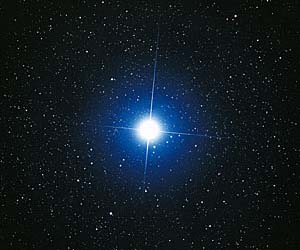Sirius StarSolarSystemQuick.com
|
|

Sirius is so bright that it can even be seen during the day in some areas.

Sirius A with its small white dwarf companion Sirius B on the right.
Sirius RadiusSirius A has a radius of 740,000 miles (1.2 million km), which is 71% larger than the radius of the sun, Sirius B has a radius of only 3,650 miles (5,900 km) which makes it slightly smaller than planet Earth!Sirius MassSirius A has twice the mass of our sun, despite Sirius B being similar in size to Earth it has almost the same mass as the sun, making it an incredibly dense object.Sirius TemperatureSirius A is estimated to have surface temperatures of around 10,000C (18,000F), almost twice as hot as the sun, Sirius B has surface temperatures of around 25,000C (45,000F), which is almost five times as hot as the sun.
Sirius Statistics
Also Known As: Alpha Canis Major, the Dog StarDistance From Earth: 8.6 light years Constellation: Canis Major Sirius A Star Type: Class A - Main sequence white star Sirius B Star Type: White Dwarf Sirius A Mass: 2.02 x Sun Sirius B Mass: 0.98 x Sun Sirius A Luminosity: 25 x Sun Sirius B Luminosity: 3% of Sun Sirius A Diameter: Approx 1.5 million miles (2.4 million km) - 171% x Sun Sirius B Diameter: Approx 7,300 miles (11,800 km) - 92% x Earth Sirius A Temperature: Approx 10,000C (18,000F) Sirius B Temperature: Approx 25,000C (45,000F) Age of System: Approx 240 million years old |
|
Copyright Source: www.solarsystemquick.com This web site is a Jan.-Feb. 2018 accessed archive copy of the original version, saved at TYCHOS.info to preserve the web reference. External links may no longer be valid. Source URL: https://www.solarsystemquick.com/universe/sirius-star.htm According to the |